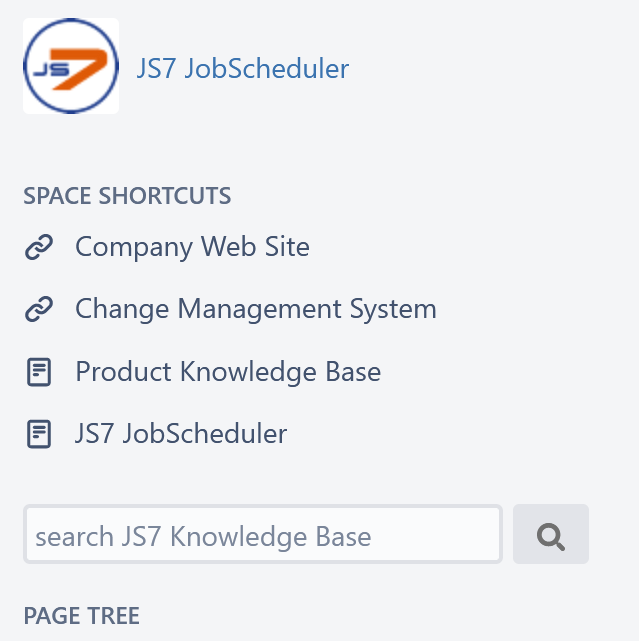Introduction
Users have a choice of how they get started with the JS7: by use of the Online Demo, Installation for Containers or Installation On Premises.
Please have a quick look at the JS7 - System Architecture section that explains the products and platforms involved.
Note that the Product Knowledge Base includes technical information about both products JS1 (JobScheduler branch 1.x) and JS7 (JobScheduler branch 2.x).
When searching for JS7 articles apply one of the following measures:
- use the "search JS7 space" box in the left panel that displays search results related to JS7:
- when using the advanced search box in the upper right panel then prefix your search with the term "js7", for example use "js7 git" if you are looking for information about how to integrate with Git repositories:
- when using the advanced search box in the upper right panel then filter results to the JS7 space like this:
License
JS7 is comes with dual licensing - an Open Source License (GPLv3) and a Commercial License for enterprise customers. For details see the JS7 - License article.
- The same source code and therefore the same functional features are available with both license models. The operational feature of clustering the JS7 products for high availability is a commercially available feature.
- Professional services including Product Maintenance, Support Options and Services, such as Training, Implementation and Migration services are available with a Commercial License.
- Access to our ticket system, 24/7 Support and guaranteed Service Levels are available for Commercial License holders.
- We support users of the Open Source License with Community Resources including the public SourceForge JobScheduler Ticket System and SourceForge JobScheduler Discussion Forums.
Online Demo
Use the Online Demo which is immediately available:
- From the above page, register for an online demo. You should receive your personal access data by mail within a minute.
- You can try out a number of JS7 - Features. Find explanations about available use cases from the JS7 - Online Demo section.
Installation
Installation for Containers
Use the JS7 - Installation for Containers section to pull images ready to run with Docker®, Kubernetes®, OpenShift® and a number of other platforms.
For evaluation purposes, the embedded H2® database included with JOC Cockpit can be used. For use with any other DBMS see the JS7 - Database article.
Installation On Premises
Use the JS7 - Download section to download the software to your environment, then proceed with the JS7 - Installation On Premises section.
For evaluation purposes, the JOC Cockpit installer offers an embedded H2® database. For use with any other DBMS see JS7 - Database.
Initial Operation
Find information about setting up your scheduling environment in the JS7 - Initial Operation section.
Defaults
To give you an easy start, we suggest that you download some presets that you can import into JOC Cockpit from the Configuration view - for details see JS7 - Inventory Export and Import:
- Download (.zip import): https://download.sos-berlin.com/JobScheduler.2.3/Defaults.zip
- After importing the
Defaults.ziparchive, a folder with the nameDefaultsbecomes available which includes JS7 - Job Resources for publishing global JS7 - Job Environment Variables to your shell jobs. - To deploy defaults to your JS7 Controller, see JS7 - Deployment of Scheduling Objects.
Examples
You might be interested in downloading a number of examples of workflows and jobs for operation with Agents on Unix and Windows respectively. The examples can be helpful for creating your own workflows and job dependencies. The examples correspond to those that you will find in the JS7 - Online Demo. Please import the Defaults as explained in the previous section before importing examples.
- Download Examples for use with Unix Agents (.tar.gz import): https://download.sos-berlin.com/JobScheduler.2.3/Examples.tar.gz
- Download Examples for use with Windows Agents (.zip import): https://download.sos-berlin.com/JobScheduler.2.3/Examples.zip
Unix examples make use of the Agent Name primaryAgent, Windows examples use the Agent Name windowsAgent. You can modify the Agent assignment with the example jobs or you can create this Agent Alias Name (recommended), see JS7 - Initial Operation for Standalone Controller. Then deploy & release examples to your JS7 Controller, see JS7 - Deployment of Scheduling Objects.
Get in Contact
For contacts about JS7:
send your comments, questions or problem reports as Feedback
send your questions about professional support & services by e-mail to: sales@sos-berlin.com
For technical assistance
Feature Videos
How to create your first job and workflow
This initial video presents the "hello world" example.
How to fork jobs for parallel execution
This video explains how to create parallel jobs in a workflow that can be nested and joined.
How to manage job errors
This video explains how to automate the handling of job errors in workflows.
How to manage conditional processing
This video explains how to manage conditional processing in a workflow.
How to limit parallel execution of jobs
This video explains how to limit parallel execution.
How to parameterize workflows and pass variables to jobs
This video explains how to parameterize workflows and pass variables to jobs in a workflow.
How to start workflows from incoming files
This video explains how to manage file watching.


